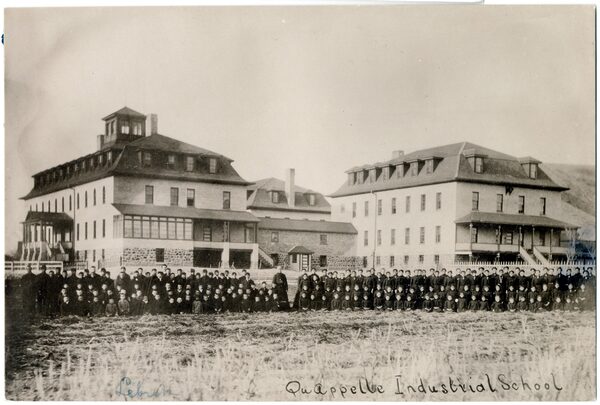
The Star Blanket Cree Nation in Saskatchewan says ground-penetrating radar has discovered possible anomalies at the site of the former Qu'Appelle residential school near Lebret, Sask., one of the longest-running residential schools in the country.HO/The Canadian Press
A Saskatchewan First Nation that announced it had discovered hundreds of subterranean “anomalies” during a search for unmarked graves is the first in almost two years of such discoveries in Canada to offer a clear blueprint to determine what definitively lies underground.
The Star Blanket Cree Nation, located about 70 kilometres northeast of Regina, said Thursday that it found a child’s jawbone on the surface and more than 2,000 underground abnormalities at the site of a former residential school. It used ground-penetrating radar, which can’t differentiate human remains from other soil disturbances.
In coming months, the First Nation said it will deploy cutting-edge DNA identification techniques to determine what, or who, lies beneath.
Axiom Exploration Group, a Saskatoon-based geology and engineering company, is set to soon begin extracting core samples from each of the 2,000 sites, much like the process used in mining exploration, and testing each sample for the presence of DNA. The method would comply with direction from elders and knowledge-keepers in the community to avoid disturbing any confirmed remains, said Sheldon Poitras, the search lead at Star Blanket.
The First Nation’s plan could provide a template for other communities searching for unmarked graves across the country. Since Tk’emlúps te Secwépemc First Nation in British Columbia announced it had discovered around 200 probable unmarked gravesites using ground-penetrating radar in 2021, upward of 80 other communities have launched searches of their own. Of those, 13 have announced preliminary radar results.
Mr. Poitras said the 2,000 abnormalities discovered on the Star Blanket Cree Nation don’t necessarily mean they are unmarked graves. “It could be a stone under the ground, it could be a clump of gravel, it could be a piece of wood, or it could actually be something. We don’t know yet.”
The community has been given permission to test the core-sampling method on a nearby Catholic cemetery.
During the Star Blanket search, the blips received from the ground-penetrating radar were all found between one and eight feet below ground; the jawbone turned up on the surface, next to a gopher hole.
A security guard found the mandible fragment while walking the grounds on Oct. 2. It has since been examined by police and the Saskatchewan Coroners Service, said Mr. Poitras. The bone is believed to come from a child aged four to six and dates to about 1898.
At the time, the grounds where the bone was discovered would have formed a front yard for the Qu’Appelle Roman Catholic Industrial School, later known as the Lebret Indian Industrial School, which opened in 1884.
Pictures from around the turn of the century show agricultural activity on the grounds, but no graves.
The bone is “physical evidence, physical proof, of an unmarked grave,” said Mr. Poitras.
Community researchers are scouring death records kept by the school to identify the remains. Final confirmation will require DNA testing because of the number of students who died around the same time, said lead researcher Sherrie Bellegarde. “There was a lot of death,” she said. “When we went through [the records], it was really hard on our research team.”
In the 1890s and early 1900s, countless students died of influenza, measles and tuberculosis.
Prime Minister Justin Trudeau called the discovery “difficult news” and Crown-Indigenous Relations Minister Marc Miller attended the announcement by Zoom. “The finding of human remains of a very young child at the site of Lebret Residential School is not only a tragic reminder of Canada’s painful history and of the heinous acts that were committed in residential schools, it’s further proof of that,” Mr. Miller stated on Twitter.
The Lebret school operated under various incarnations from 1884 until 1998. It was run by Roman Catholic orders until 1969, when the federal government assumed control. Starting in the early 70s, it was co-managed by Ottawa and a local council made up of 24 district chiefs until the community took ownership in 1984.
“It was unthinkable. It was profound. It was sad. It was hurtful,” Chief Michael Starr said of what took place at the residential school. “And it made us very angry what had happened to our young people here.”
One survivor of the school told of how she was taken from her parents.
“They tried to take our spirits away. They tried to take the Indian out of us,” said Sharon Strongarm. “But thank the Creator we are back here, strong as we will ever be, helping each other.”
 Patrick White
Patrick White